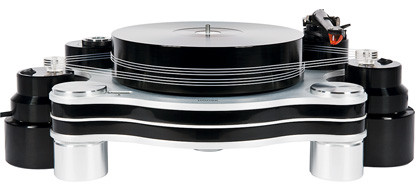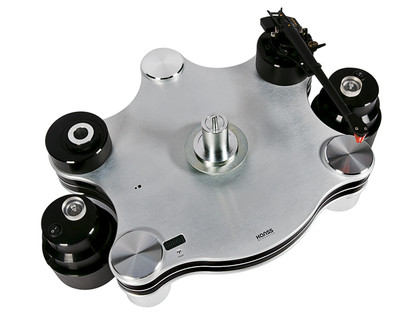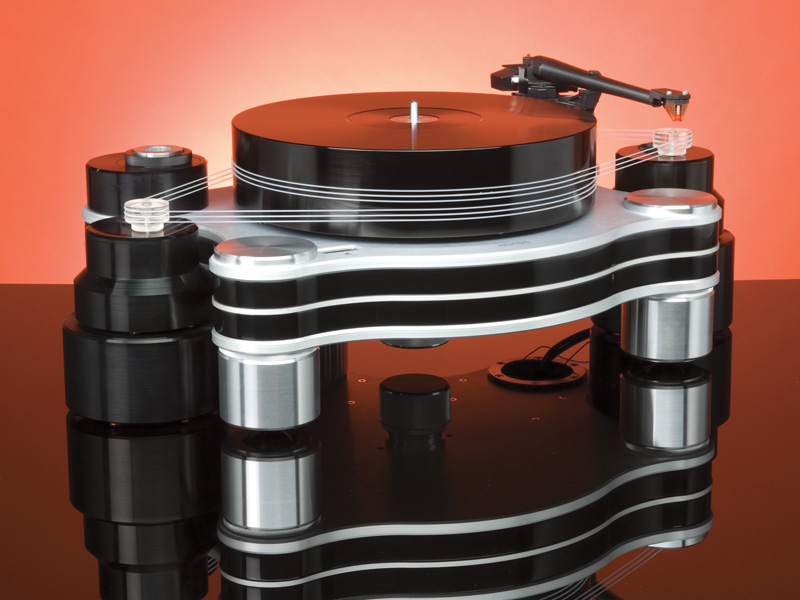TechRadar Verdict
If image stability, and bass that's precise and powerful, are your bag, then buy this turntable. It's also the only multi-arm base deck in its price range and this combined with sheer material value make it impossible not to recommend
Pros
- +
Amazing engineering for the money
- +
High-mass turntables have never offered so much value
- +
Imaging is superb and the bass is sensational
Cons
- -
Good, but the Townshend Rock V turntable does it so much better
- -
Support is an issue
Why you can trust TechRadar
In a move that could shake the foundations of the high-end analogue world, Hanss Acoustics has created the T-30 – a high mass (37.8kg), multi-arm turntable that can be snapped up for just £3,600.
Chinese company Hanss Acoustic makes phono stages, equipment supports and a CD player but its range of turntables is something else. The T-30 is the middle model of three substantial turntables with impressive build and an awful lot of precisely turned aluminium for the money.
With two substantial motors, two armbases, a separate power supply, and no fewer than six belts, it ticks all the boxes for the hardcore analogue fiend. All you need is a big enough equipment support.
Heavy duty
The T-30 is an awful lot of engineering for £3,600. We've yet to test anything that compares to its near 40-kilogram mass – only the extreme end of German and French designs get close, but with price tags to match.
The Hanss T-30 is a very substantial turntable: its platter is 70 millimetres deep and weighs 10 kilograms on its own. The total turntable weight is a staggering 37.8 kilograms and it stands over 60 centimetres wide. But there's more to this baby than mass.
The chassis is a sandwich of aluminium and acrylic, a design approach that Clearaudio has been using for some time. Suspension comes in the form of opposing magnets in the three ball feet, a technique used in the Lumley Stratosphere, albeit rather more than three times, and at stratospheric cost.
The platter's bearing that you can see if you look at the turntable side on, also has magnetic suspension, which is a little unusual, but something of a necessity when you have such a high-mass platter. In practice, the T-30 feels and looks like an unsuspended design and has the same sensitivity to footfall.

The arm bases are supplied in SME and Rega fit and can be switched from one side to the other if you are prepared to undo the eight bolts that hold them in place. I used an SME V tonearm, but was unable to fit the standard arm cable plug because of insufficient space inside the base. Fortunately, I was able to borrow an alternative cable with a plug that sends the cable straight down.
The Rega base accepts the RB300 style threaded column Rega arms and has built in VTA adjustment, which is a useful feature. The huge motor housings have weighted bases and are totally independent of the turntable itself.
In fact, it's not entirely clear how close they should be nor how to orient them, but looking at the pictures on the Hanss site you get the impression that the on/off switches should be at the back.
The AC motors power acrylic pulleys with three grooves in them, each of which drives a silicon belt. You'll notice that each motor is a different height so that all six belts can be run without interference. Each motor has its own cable, which plugs into a separate power supply with which you can turn them on and off and select speed. You can also fine tune speed if you have a small screwdriver and a light touch.
On top of the plinth is a speed display with three decimal places – getting it to read 33.333 is quite a feat but it can be done with a little patience. Hanss supplies a record clamp which, to be frank, is too lightweight to do a great deal as it doesn't screw down.
Also in the box is a strobe disc, which has a cartridge alignment gauge on one side as well as a circular spirit level to aid set up. Small but nice touches both.
Base metal
The quality of CNC machining is impressive on this turntable – not in the very top league but remarkable for the asking price and about as good as I have seen on a Chinese component. It's well put together and easy, if heavy work, to set up.
One snag is that the armbase for the SME seems a little too high – you have to push the arm down as far as it will go to get correct VTA. With two of the three cartridges tried the base was only just close enough to the platter to achieve correct alignment.
In other respects, fit and finish is very good and the hardcoat anodising on the platter particularly well done. The way that the six belts all sit equidistant on the platter is also very pleasing to the eye and threading them on is a doddle, if you are methodical.
Added value
To my knowledge, no-one offers this much turntable for this sort of money – there isn't even a model that will accept two tonearms in this ballpark. Fortunately, for the competition, there's more to record playing than extra armbases and mass.
The T-30 has plenty of competition from the likes of Kuzma, whose Stabi-S is remarkably musical as is the superbly finished SME Model 10. If you want high mass however, the only alternatives are the big money TW Acustic Raven AC, which also has a 10 kilogram platter, or Acoustic Solid's Solid One, which isn't quite as hefty but comes in at a competitive £4,000.
Sound quality
Being over 60 centimetres wide makes T-30 something of a challenge to site on conventional equipment supports and you'll really need something big like a finite elemente or even one of Hanss Acoustics stands for best results. I made a bigger top plate for my Townshend stand, which looked a bit ungainly but did the job.
With an SME V tonearm and van den Hul Condor XCM cartridge installed, and the output fed to Trichord's venerable Delphini phono stage, the Hanss delivers an extremely stable and powerful result that makes for powerful, full-blooded sound.
This is typical of high-mass designs, but most models do not have two motors. it's impossible to say what the second motor brings to the sound because one is not enough to keep the platter spinning. The most likely effect is to underpin the unflappable quality already produced by the platter.

It doesn't draw your attention to qualities like timing but a rhythmically tricky piece like the Keith Jarrett trio's Scrapple for the Apple came across in remarkably engaging and coherent form, which suggests that it's not too shabby in this department. I even enjoyed the double bass solo and that's saying something.
Next to my regular turntable, the Rock 7 with a Rega RB300, the Hanss is more definite and precise, not as relaxed nor timely but despite the lack of a damping trough (as found on the Rock) probably its equal in the bass department. It could be a little more relaxed, but if you want plenty of bite – and this is what gives the bass its definition – then the T-30 is a hard act to beat.
There is something a little unforgiving about the turntable that I suspect, is due to the metal surface of the platter, and it pays to use a cartridge and arm that balance this out. I found the perfect match in the form of a van den Hull Colibri. This plastic bodied MC did the trick, bringing relaxation and refinement to the proceedings and allowing artists including Rickie Lee Jones to deliver their full emotional breadth.
In fact, her track horses became beguiling in its grip, with instrumental and vocal texture that could sway the hardest heart.
Sonic architecture
Hanss Acoustics brings the entry level for high mass turntables down to a new low and that's something to get excited about. It's not the easiest piece of equipment to site but there are some stands, including Hanss' own, built for components of this scale.
While it won't sway the rhythm and timing brigade its remarkable precision and stability means that given a good recording, the speakers disappear to leave a three-dimensional image of genuine architectural solidity in the room.
So, if you want to seriously hear the power of vinyl, then the T-30 is the least expensive way to do it.
Follow TechRadar Reviews on Twitter: http://twitter.com/techradarreview
